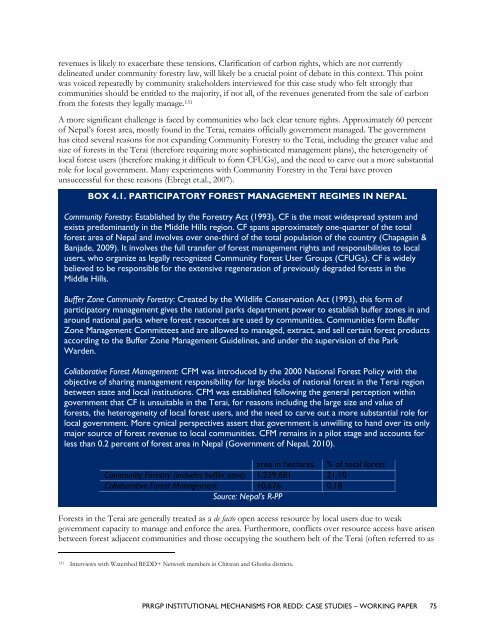Institutional Mechanisms for REDD+ - Case Studies Working Paper
Institutional Mechanisms for REDD+ - Case Studies Working Paper
Institutional Mechanisms for REDD+ - Case Studies Working Paper
Create successful ePaper yourself
Turn your PDF publications into a flip-book with our unique Google optimized e-Paper software.
evenues is likely to exacerbate these tensions. Clarification of carbon rights, which are not currently<br />
delineated under community <strong>for</strong>estry law, will likely be a crucial point of debate in this context. This point<br />
was voiced repeatedly by community stakeholders interviewed <strong>for</strong> this case study who felt strongly that<br />
communities should be entitled to the majority, if not all, of the revenues generated from the sale of carbon<br />
from the <strong>for</strong>ests they legally manage. 131<br />
A more significant challenge is faced by communities who lack clear tenure rights. Approximately 60 percent<br />
of Nepal‘s <strong>for</strong>est area, mostly found in the Terai, remains officially government managed. The government<br />
has cited several reasons <strong>for</strong> not expanding Community Forestry to the Terai, including the greater value and<br />
size of <strong>for</strong>ests in the Terai (there<strong>for</strong>e requiring more sophisticated management plans), the heterogeneity of<br />
local <strong>for</strong>est users (there<strong>for</strong>e making it difficult to <strong>for</strong>m CFUGs), and the need to carve out a more substantial<br />
role <strong>for</strong> local government. Many experiments with Community Forestry in the Terai have proven<br />
unsuccessful <strong>for</strong> these reasons (Ebregt et.al., 2007).<br />
BOX 4.1. PARTICIPATORY FOREST MANAGEMENT REGIMES IN NEPAL<br />
Community Forestry: Established by the Forestry Act (1993), CF is the most widespread system and<br />
exists predominantly in the Middle Hills region. CF spans approximately one-quarter of the total<br />
<strong>for</strong>est area of Nepal and involves over one-third of the total population of the country (Chapagain &<br />
Banjade, 2009). It involves the full transfer of <strong>for</strong>est management rights and responsibilities to local<br />
users, who organize as legally recognized Community Forest User Groups (CFUGs). CF is widely<br />
believed to be responsible <strong>for</strong> the extensive regeneration of previously degraded <strong>for</strong>ests in the<br />
Middle Hills.<br />
Buffer Zone Community Forestry: Created by the Wildlife Conservation Act (1993), this <strong>for</strong>m of<br />
participatory management gives the national parks department power to establish buffer zones in and<br />
around national parks where <strong>for</strong>est resources are used by communities. Communities <strong>for</strong>m Buffer<br />
Zone Management Committees and are allowed to managed, extract, and sell certain <strong>for</strong>est products<br />
according to the Buffer Zone Management Guidelines, and under the supervision of the Park<br />
Warden.<br />
Collaborative Forest Management: CFM was introduced by the 2000 National Forest Policy with the<br />
objective of sharing management responsibility <strong>for</strong> large blocks of national <strong>for</strong>est in the Terai region<br />
between state and local institutions. CFM was established following the general perception within<br />
government that CF is unsuitable in the Terai, <strong>for</strong> reasons including the large size and value of<br />
<strong>for</strong>ests, the heterogeneity of local <strong>for</strong>est users, and the need to carve out a more substantial role <strong>for</strong><br />
local government. More cynical perspectives assert that government is unwilling to hand over its only<br />
major source of <strong>for</strong>est revenue to local communities. CFM remains in a pilot stage and accounts <strong>for</strong><br />
less than 0.2 percent of <strong>for</strong>est area in Nepal (Government of Nepal, 2010).<br />
area in hectares % of total <strong>for</strong>est<br />
Community Forestry (includes buffer zone) 1,229,681 21.10<br />
Collaborative Forest Management 10,676 0.18<br />
Source: Nepal’s R-PP<br />
Forests in the Terai are generally treated as a de facto open access resource by local users due to weak<br />
government capacity to manage and en<strong>for</strong>ce the area. Furthermore, conflicts over resource access have arisen<br />
between <strong>for</strong>est adjacent communities and those occupying the southern belt of the Terai (often referred to as<br />
131 Interviews with Watershed <strong>REDD+</strong> Network members in Chitwan and Ghorka districts.<br />
PRRGP INSTITUTIONAL MECHANISMS FOR REDD: CASE STUDIES – WORKING PAPER 75

















